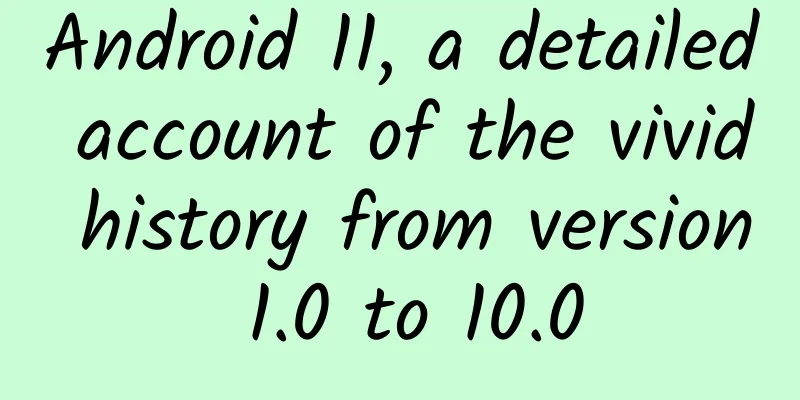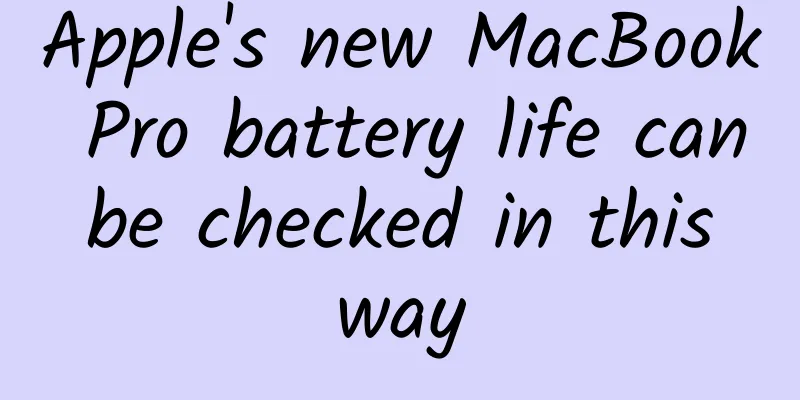Android 11, a detailed account of the vivid history from version 1.0 to 10.0

|
From its first release in 2008 to today, from version 1.0 to 10, it has taken 11 years. Android has undergone visual, conceptual and functional transformations again and again, and it has also transformed from a quirky piece of software to a mature operating system and a strong brand. Google's mobile operating system may have been rough at the beginning, but it has evolved. So, what is the evolution of Android? Let's take a fast-paced tour of Android versions to find out. Android 1.0 to 1.1: Early versions Android made its official public debut in 2008 with Android 1.0 — a version so old it didn't even have a cute code name. Everything was pretty basic back then, but the software did include a suite of early Google apps, like Gmail, Maps, Calendar, and YouTube, all integrated into the OS — a stark contrast to the more easily updated standard app model used today. Android 1.0 on early smartphones Android 1.5: Cupcake The tradition of Android version names was born with the release of Android 1.5 Cupcake in early 2009. Cupcake introduced many improvements to the Android interface, including the first on-screen keyboard—a necessity as phones moved away from the once-ubiquitous physical keyboard model. Cupcake also introduced a framework for third-party app widgets, which would quickly become one of Android's most notable elements, and provided the platform's first video recording option. Cupcakes are widgets Android 1.6: Donut Android 1.6 Donut arrived in the fall of 2009. Donut filled in some important holes in the heart of Android, including the ability for the operating system to run on different screen sizes and resolutions—something that would be a critical factor in the coming years. It also added support for CDMA networks like Verizon's, which would play a key role in Android's upcoming explosion in growth. Android 1.6 Donut Google (Android's universal search box first appeared in Android 1.6) Android 2.0 to 2.1: Eclair Android 2.0 Eclair followed in the footsteps of early Android releases, arriving just six weeks after Donut. A few months later, its "0.1" upgrade, also called Eclair, was released. Eclair was the first version of Android to enter mainstream consciousness, thanks to the original Motorola Droid phone and the massive Verizon-led marketing campaign that surrounded it. The most transformative element of the launch was the addition of voice-activated navigation and real-time traffic information — something that was unheard of (and essentially unmatched) in the smartphone world. In addition to navigation, Eclair brought live wallpapers to Android, as well as the platform's first speech-to-text feature. It also made waves by bringing the once-iOS-only zoom feature to Android — a move often seen as the spark that ignited the enduring "thermonuclear war" between Apple and Google. Android 2.0, 2.1, 2.2 Eclair Android 2.2: Froyo (Frozen Yogurt) Just four months after the release of Android 2.1, Google launched Android 2.2 Froyo, which mainly focused on low-level performance improvements. Froyo did offer some important front-end features, including the addition of the now-standard home screen bottom bar and the first incarnation of the voice assistant, which allowed you to perform basic functions like tapping an icon and then speaking a command to ask for directions and take notes. Android version 2.2 Froyo (Google's first attempt at voice control) Notably, Froyo also brought support for Flash to Android's web browser - a choice that was significant not only because of Flash's widespread use at the time, but also because Apple was adamantly against supporting Flash on its own mobile devices. Apple won out, of course, and Flash became less common. But while it was still ubiquitous, being able to access the full web without any black holes was a real advantage that only Android could offer. Android 2.3: Gingerbread Android's first real visual identity began to gain traction with the release of Gingerbread in 2010. Bright green has always been the color of the Android robot mascot, and with Gingerbread, it became an integral part of the operating system's look. As Android began its slow march toward a unique design, black and green permeated the entire UI. Android 2.3 Gingerbread / IDG Android 3.0 to 3.2: Honeycomb Honeycomb 2011 was a strange time for Android. Android 3.0 arrived as a tablet version with the launch of the Motorola Xoom, and through the subsequent 3.1 and 3.2 updates it remained a tablet-only (and closed-source) entity. Under the guidance of newly appointed design director Matias Duarte, Honeycomb introduced a completely new user interface for Android that featured a space-like "holographic" design, swapped the platform's signature green for blue, and emphasized making the most of tablet screen real estate. Android 3.0 3.1 3.2 Honeycomb/IDG While the concept of a tablet-specific interface didn't last long, many of Honeycomb's ideas laid the foundation for Android as we know it today. The software was the first to use on-screen buttons for Android's primary navigation commands; it marked the beginning of the end of the permanent overflow menu button; and it introduced the concept of a card-like UI with the recent apps list. Android 4.0: Ice Cream Sandwich Honeycomb served as a bridge between the old and the new, while Ice Cream Sandwich, also released in 2011, served as the platform's official entry into the modern design era. This release improved on the visual concepts introduced in Honeycomb and combined tablets and phones to achieve a unified UI vision. ICS removes much of Honeycomb's "holographic" look, but retains the use of blue as a system-wide highlight. It also carries over some core system elements, such as on-screen buttons and a card-like appearance for app switching. Android 4.0 Ice Cream Sandwich/IDG Android 4.0 also made swiping a more complete way to navigate the OS, a revolutionary feature at the time, allowing for swiping through things like notifications and recent apps. It began the slow process of introducing a standardized design framework dubbed "Holo" across the OS and Android app ecosystem. Android 4.1 to 4.3: Jelly Bean Spread across three influential Android versions, the 2012 and 2013 releases of Jelly Bean made meaningful tweaks and built upon the clean-sheet foundation of ICS. These releases added a great deal of balance and polish to the OS, and went a long way toward making Android more appealing to the average user. Visuals aside, Jelly Bean gave us our first taste of Google Now—a compelling predictive intelligence tool that unfortunately became a glorified information stream. It gave us expandable, interactive notifications, an expanded voice search system, and a more advanced system for displaying search results, with an emphasis on its card-based search results that tried to directly answer questions. Multi-user support also came into play in that version, albeit only on tablets, and an early version of the Android Quick Settings panel made its debut. Jelly Bean introduced a much-hyped system for placing widgets on a user's lock screen. Android 4.1 4.2 4.3 Jelly Bean/IDG Android 4.4: KitKat The release of KitKat in late 2013 marked the end of Android's dark era, with the black of Gingerbread and the blue of Honeycomb finally leaving the operating system. Lighter backgrounds and more neutral highlights took their place, and a transparent status bar and white icons gave the operating system a more modern look. Android 4.4 also supported the first version of "OK, Google," but on KitKat, the hands-free activation prompt only worked when your screen was already on and you were either on your home screen or inside a Google app. Android 4.4 KitKat/ IDG Android 5.0 and 5.1: Lollipop Google essentially reinvented Android with the release of Android 5.0, Lollipop, in the fall of 2014. Introducing the Material Design standard that's still in use today, Lollipop brought a fresh new look that extended across all of Android, apps, and even other Google products. The decentralized card-based concept in Android became a core UI pattern — it would guide the look of everything, from notifications (which now appeared on the lock screen for quick access), to the recent apps list. Android 5.0 and 5.1 Lollipop/ IDG Lollipop introduced a host of new features to Android, including true hands-free voice control via the "OK, Google" command, support for multiple users on the phone, and a priority mode for better notification management. Unfortunately, it was a huge change, and also introduced a bunch of annoying bugs, many of which wouldn't be fully addressed until the upcoming 5.1 release. Android 6.0: Marshmallow In the grand scheme of things, 2015's Marshmallow was a pretty minor version of Android — it felt more like a 0.1-level update than anything worthy of a full-blown upgrade. But it kicked off Google's trend of releasing one major version of Android per year. The most eye-catching element of Marshmallow was an on-screen search feature called Now On Tap, a system that Google never fully perfected and eventually quietly retired from its branding and removed from the forefront the following year. Android 6.0 Marshmallow/ IDG Android 6.0 did introduce some things that had lasting impact, including more granular app permissions, support for fingerprint readers, and support for USB-C. Android 7.0 and 7.1: Nougat Google's 2016 release of Android Nougat gave Android a native split-screen mode, a new app bundling system to organize notifications, and a data saver feature. Nougat also added some smaller but still important features, like an Alt-Tab-style shortcut for taking photos between apps. Android 7.0 Nougat / IDG Perhaps most critical of Nougat's enhancements, however, is the introduction of the Google Assistant -- which comes about two months after the release of the Pixel, Google's first phone built entirely in-house. The Assistant will become a key component of Android and most other Google products, and is arguably the company's most important endeavor right now. Android 8.0 and 8.1: Oreo Android Oreo adds a lot of niceties to the platform, including a native picture-in-picture mode, a notification snooze option, and notification channels that give fine control over how apps alert users. Android 8.0 Oreo/ IDG The 2017 version also introduced some notable elements that advanced Google's goals of aligning Android and Chrome OS to improve the experience of using Android apps on Chromebooks, and it was the first Android version to feature Project Treble — an ambitious effort to create a modular foundation for the Android code in hopes of making it easier for device makers to deliver timely software updates. Android 9: Pie In August 2018, Android Pie (also known as Android 9) was released. The most revolutionary change in Pie is its hybrid gesture/button navigation system, which replaces Android's traditional Back, Home, and Overview keys with a large multi-function Home button and a small Back button. Android 9 pie/IDG Pie also includes some notable productivity features, like a universal suggested reply system for message notifications, a new dashboard for digital wellbeing controls, and a smarter system for power and screen brightness management. Of course, there are also some smaller but still significant improvements filled out in Pie, including a smarter way to handle Wi-Fi hotspots, an Android battery saver mode, and various privacy and security enhancements. Android 10 Google released Android 10 in September 2019, the first Android version to be named with numbers instead of letters, without dessert-themed names. The software brought a whole new interface to Android gestures, completely abandoning the touchable back button and relying entirely on swipe-driven system navigation. In fact, Android 10 introduces a new hotfix-style update setup that will ultimately allow for faster and more consistent rollouts of small, focused patches. The software also has a number of other important improvements, including an updated permissions system that gives users more control over how and when apps can access location data and expanded system protections for unique device identifiers. Android 10 /IDG Among other things, Android 10 includes a system-wide dark theme, a new focus mode that lets you limit distractions from specific apps by tapping a button on the screen, and a long-overdue overhaul of the Android share menu. This version also lays the foundation for a new Live Caption feature that will allow you to generate instant visual captions for any media playing on your phone - videos, podcasts, and even regular voice recordings, and while the feature isn't available immediately, it's expected to be available on Pixel phones starting later this year. |
<<: Android Framework Problem Analysis Case - Who Killed the Desktop?
>>: Is 5G real or fake? A few topics from iPhone 11
Recommend
Today is Sunday, but I have to go to work! Why does taking a day off make people so exhausted?
The May Day holiday is coming soon, but before th...
Future iPhones may use under-screen light sensors to reduce the size of the notch
Apple is working on an ambient light sensor that ...
The rooster’s crowing is so loud, why haven’t you gone deaf yet?
Gulp! ... My eyes are hurt. |Giphy How loud is a ...
Will increasing followers on a Kuaishou account affect its popularity? What are the popular skills on Kuaishou?
Many guys who have just started using Kuaishou ha...
The mobile phone market grew 17.4% year-on-year in the first half of 2021, with Xiaomi ranking second
Under the influence of the global environment, th...
The supply of new energy credits exceeds the demand, the price is falling, and the double credit policy has become ineffective?
Recently, the China Electric Vehicle 100 Associat...
The number of fans increased by more than 100,000 in 4 days. I want to talk about the research on user fission growth
After working in growth for more than a year, I s...
The world's most watched comet-Jupiter collision
Whenever we talk about how dinosaurs left the sta...
Influenza A has entered its peak period. What are the differences between its symptoms and those of COVID-19?
Recently, influenza A has entered its peak period...
How long will these IP marketing be popular?
No one can tell how long they will remain popular...
Does the sun also have "tsunamis"? New research may have solved the mystery of "tsunamis" in the solar chromosphere
There is such a horrifying scene in the Chinese s...
Is it a "leader" or a "useless"? Bull remote timing remote control socket review
The cost of sockets in smart homes is the lowest,...
How much does it cost to develop the Wuhu movie mini program? Wuhu movie applet development price inquiry
More and more businesses are paying attention to ...
Guangzhou Sleep Mini Program Function, How much does it cost to develop a sleep monitoring mini program?
Nowadays, due to increasing stress on people, the ...
Top 50 private domain strategies used by brands!
If 2020 is the first year of private domain, 2021...









